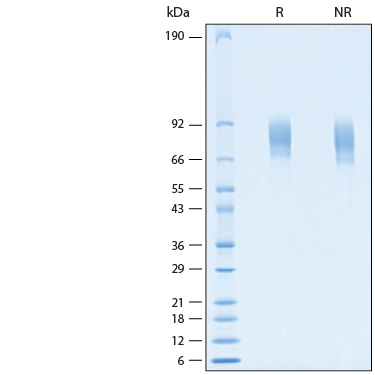Recombinant Human ALCAM/CD166 His-tag Protein, CF Summary
Product Specifications
Trp28-Ala526, with a C-terminal 6-His tag
Analysis
Product Datasheets
Carrier Free
CF stands for Carrier Free (CF). We typically add Bovine Serum Albumin (BSA) as a carrier protein to our recombinant proteins. Adding a carrier protein enhances protein stability, increases shelf-life, and allows the recombinant protein to be stored at a more dilute concentration. The carrier free version does not contain BSA.
In general, we advise purchasing the recombinant protein with BSA for use in cell or tissue culture, or as an ELISA standard. In contrast, the carrier free protein is recommended for applications, in which the presence of BSA could interfere.
11191-AL
| Formulation | Supplied as a 0.2 μm filtered solution in PBS with Trehalose. |
| Shipping | The product is shipped with dry ice or equivalent. Upon receipt, store it immediately at the temperature recommended below. |
| Stability & Storage: | Use a manual defrost freezer and avoid repeated freeze-thaw cycles.
|
Scientific Data
 View Larger
View Larger
When Recombinant Human ALCAM/CD166 His-tag Protein (Catalog # 11191-AL) is immobilized at 0.5 μg/mL (100 µL/well), Recombinant Human CD6 Fc Chimera (627-CD) binds with an ED50 of 30.0-240 ng/mL.
 View Larger
View Larger
2 μg/lane of Recombinant Human ALCAM/CD166 His-tag Protein (Catalog # 11191-AL) was resolved with SDS-PAGE under reducing (R) and non-reducing (NR) conditions and visualized by Coomassie® Blue staining, showing bands at 65-85 kDa.
Reconstitution Calculator
Background: ALCAM/CD166
Activated leukocyte cell adhesion molecule (ALCAM), also known as CD166, is a surface glycoprotein belonging to the immunoglobulin superfamily (1, 2). ALCAM, along with MCAM and BCAM/Lu, form a small subgroup of adhesion molecules involved in tissue development and maintenance, neurogenesis, and regulation of immune responses (3). Mature human ALCAM consists of an extracellular domain (ECD) containing 2 IgV and 3 IgC domains, a transmembrane domain, and a short cytoplasmic domain (1, 2). Within the ECD, human ALCAM shares 93% amino acid sequence identity with both mouse and rat ALCAM. An isoform of ALCAM with a shorter stalk region in the ECD is known to exist and is associated with higher shedding tendency and decreased cell adhesion (2). Initially found expressed on activated leukocytes, ALCAM expression has been detected in a wide variety of tissues and cells (3, 4). In addition to cell adhesion, other ALCAM functions include leukocyte migration across the blood brain barrier, T-cell activation, and osteogenesis, (2, 5, 6). Overexpression of ALCAM is often associated with poor prognosis in various human tumors, such as bladder cancer, prostate cancer, melanoma, and liver cancer (2,7).
- Bowen, M.A. et al. (1995) J. Exp. Med. 181:2213.
- Ferragut, F. et al. (2021) Cytokine Growth Factor Rev. 61:27.
- Swart, G.W. (2002) Eur. J. Cell Biol. 81:313.
- Zimmerman, A.W. et al. (2006) Blood 107:3212.
- Masedunskas, A. et al. (2006) FEBS Lett. 580:2637.
- Cayrol, R. et al. (2008) Nat. Immunol. 9:137.
- Darvishi, B. et al. (2020) Exp. & Mol. Path 115:104443.
FAQs
No product specific FAQs exist for this product, however you may
View all Proteins and Enzyme FAQsReviews for Recombinant Human ALCAM/CD166 His-tag Protein, CF
There are currently no reviews for this product. Be the first to review Recombinant Human ALCAM/CD166 His-tag Protein, CF and earn rewards!
Have you used Recombinant Human ALCAM/CD166 His-tag Protein, CF?
Submit a review and receive an Amazon gift card.
$25/€18/£15/$25CAN/¥75 Yuan/¥2500 Yen for a review with an image
$10/€7/£6/$10 CAD/¥70 Yuan/¥1110 Yen for a review without an image


